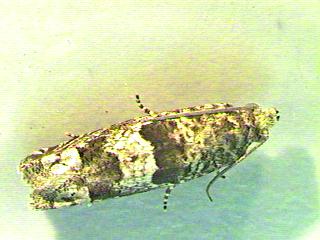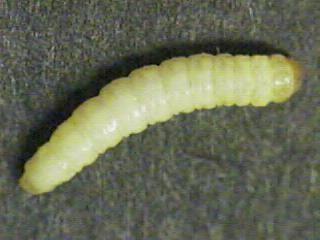Sunflower Insects
Sunflower Root Moth, Pelochrista womanana (Lepidoptera: Tortricidae)

Adult Pelochrista womanana

Larva of Pelochrista womanana
Identification
This is a small, gray, nondescript moth that can sometimes be observed flitting about the foliage of sunflower plants in vegetative growth stages. The cream-colored larvae can be found within the root crown of mature plants in late fall, or within the central core of the larger roots. They can be easily distinguished from root-boring coleopteran larvae by the presence of legs. However, root moth larvae may also be present in upper portions of the stalk during summer months where they can be easily mistaken for larvae of the bud moth, although the head capsule is not nearly as dark.
Life History and Behavior
This moth is a resident of Kansas that likely has a number of wild composite host plants, including wild sunflower. There is only one generation per year. Eggs are laid on upper parts of the plant and larvae bore into the stalk when they hatch. As larvae feed and grow, they descend the main stalk and end the season feeding gregariously within the root crown or larger roots where they eventually form overwintering chambers in the woody matrix. As the late instar larvae begin to enter diapause, they spin a silken cocoon and form a hibernacula. As many as five or six larvae may form a array of overwintering chambers around the root crown, aligned side-by-side like a series of cartridges in a revolver.
Management
The impact of root moth larval feeding on sunflower productivity is unknown, but is likely to be negligible. Although plants may be weakened at the base by multiple overwintering galleries, the galleries are not constructed until relatively late in the fall, usually after harvest, so they do not appear to contribute to preharvest lodging. No treatment is recommended for root moth, but most materials applied for stem weevils will provide control. There is also a planting date effect similar to that for stem weevils such that later planting dates typically avoid infestation.
Please refer to the most recent version of the Sunflower Insect Management Guide for specific control recommendations.
Page last updated 10/02/2013 by J.P. Michaud.